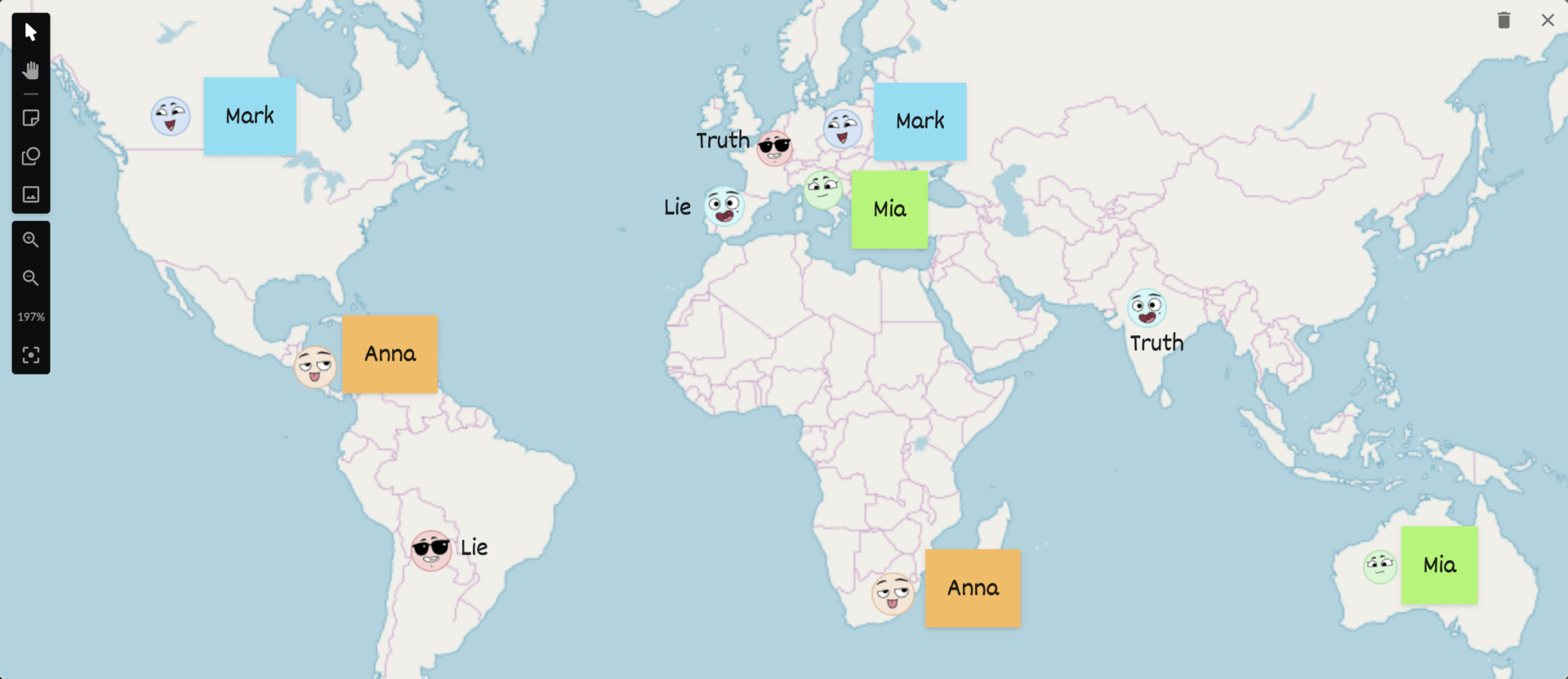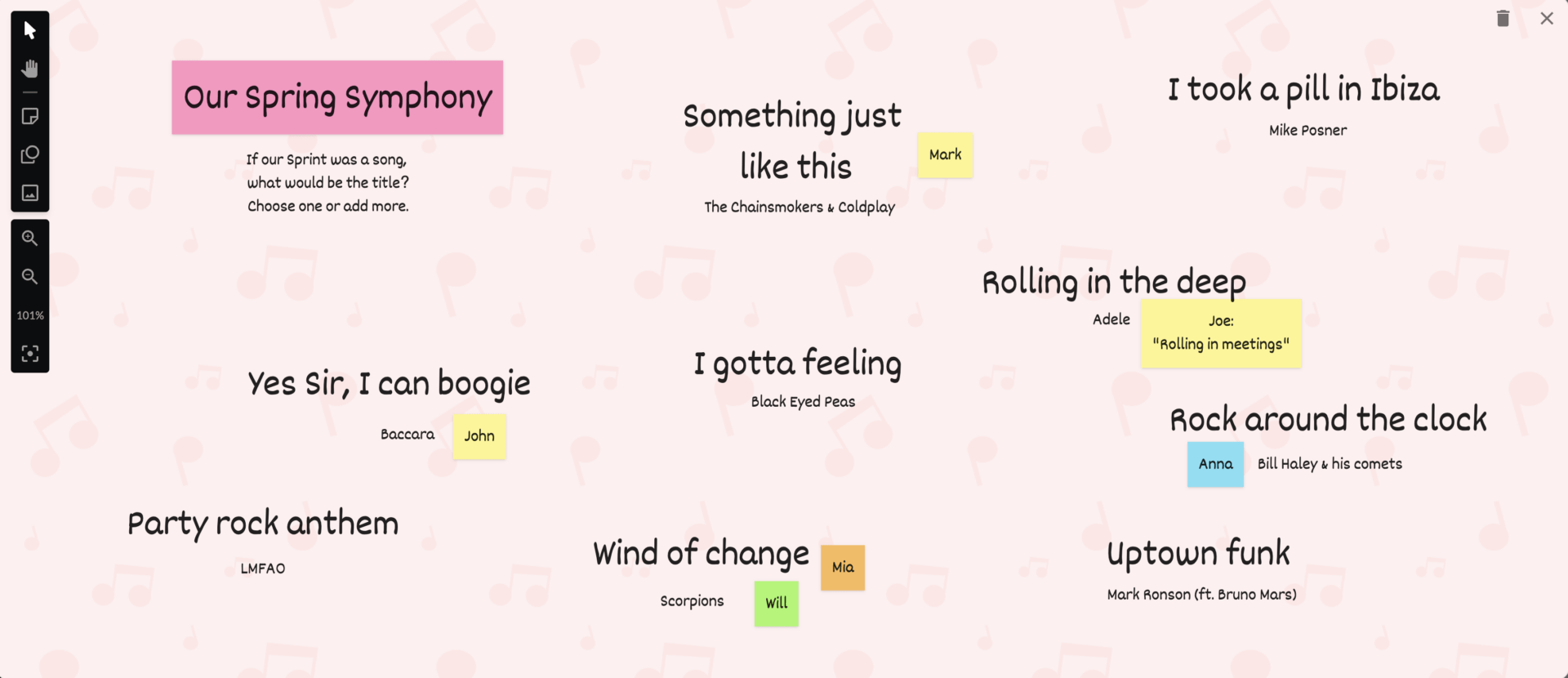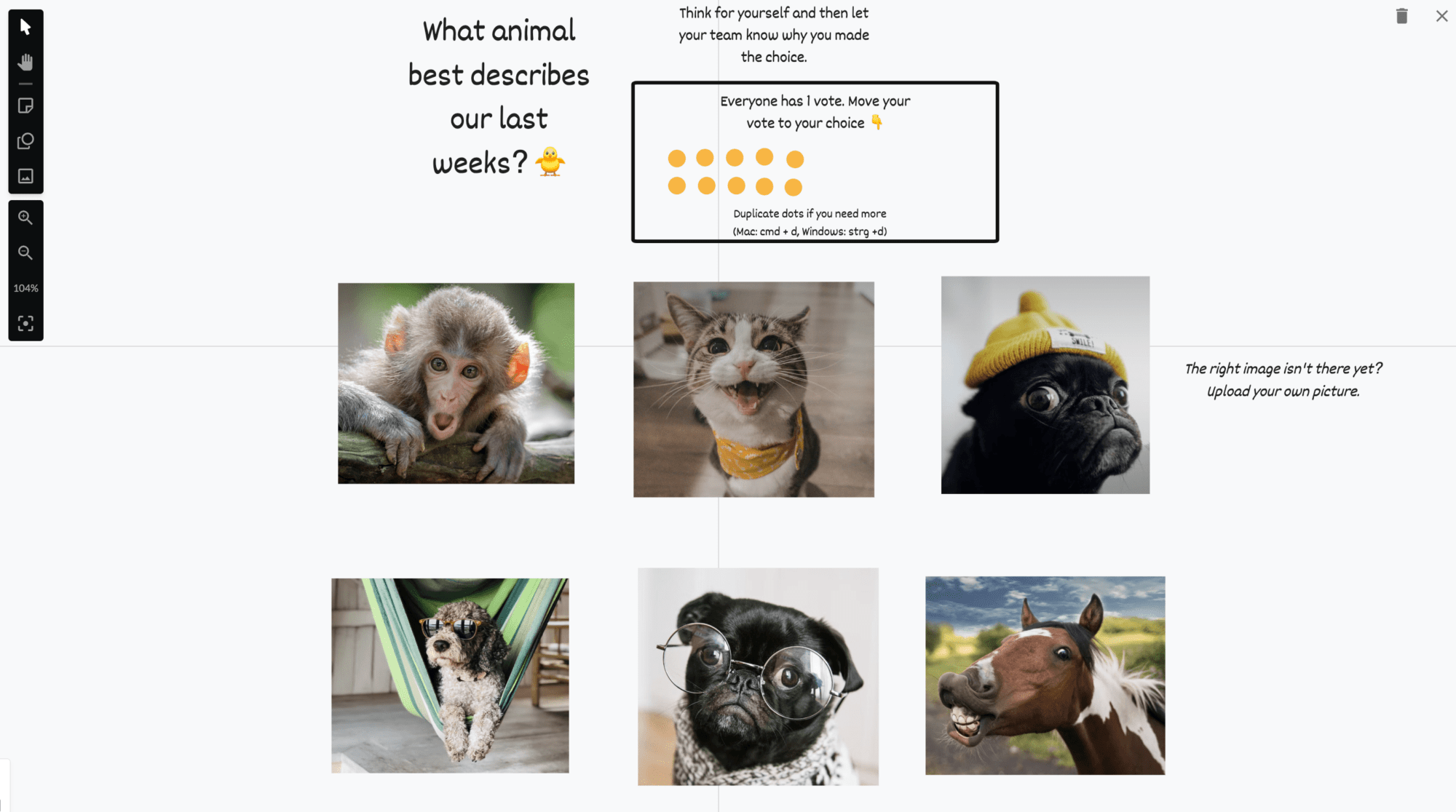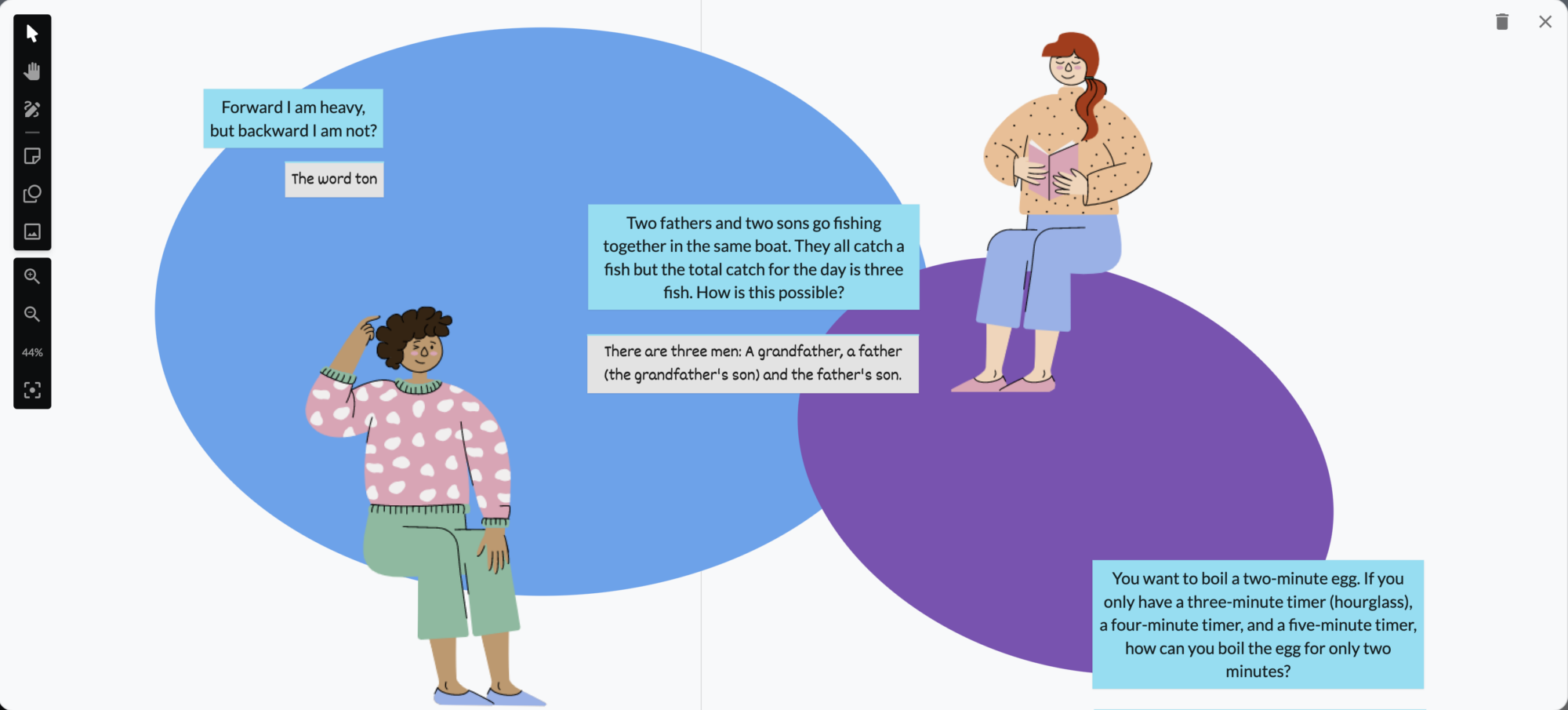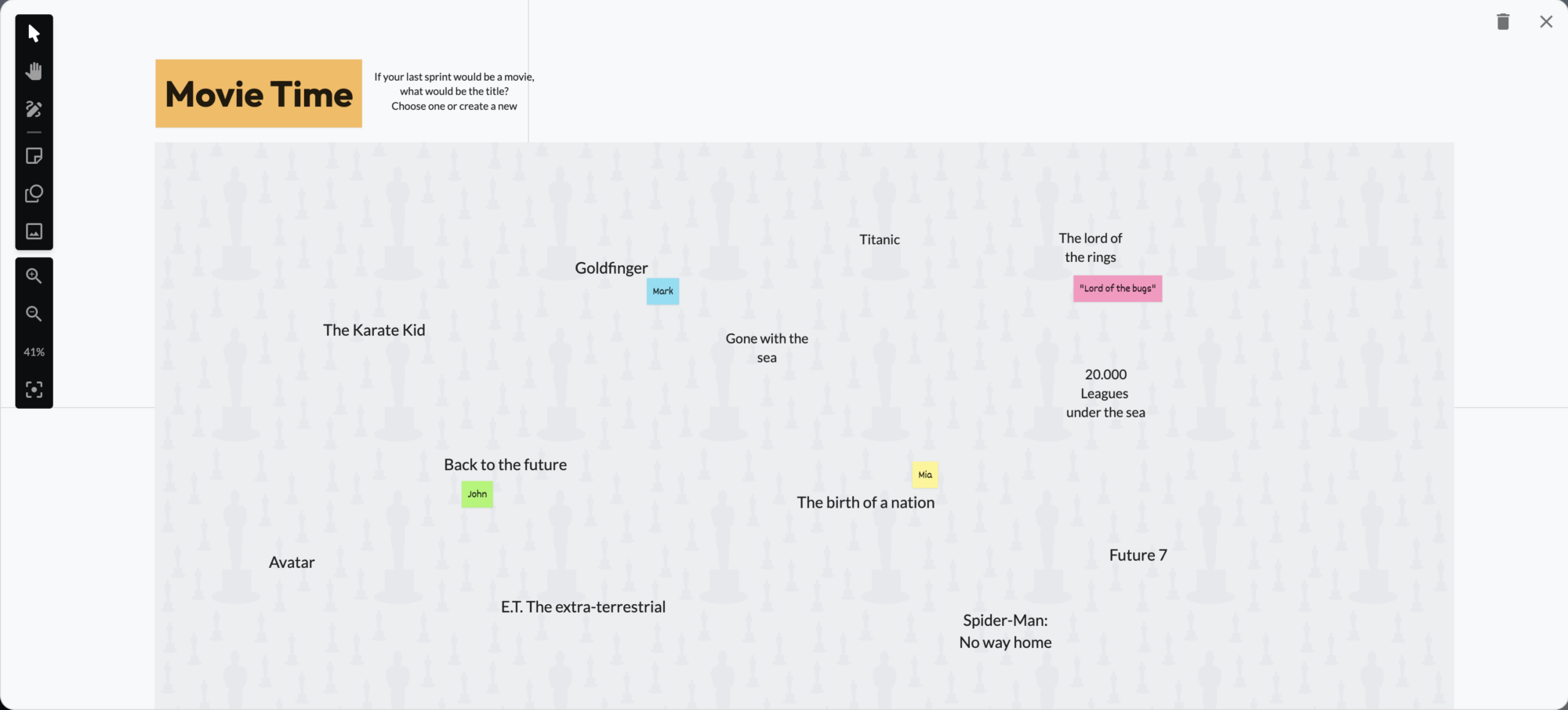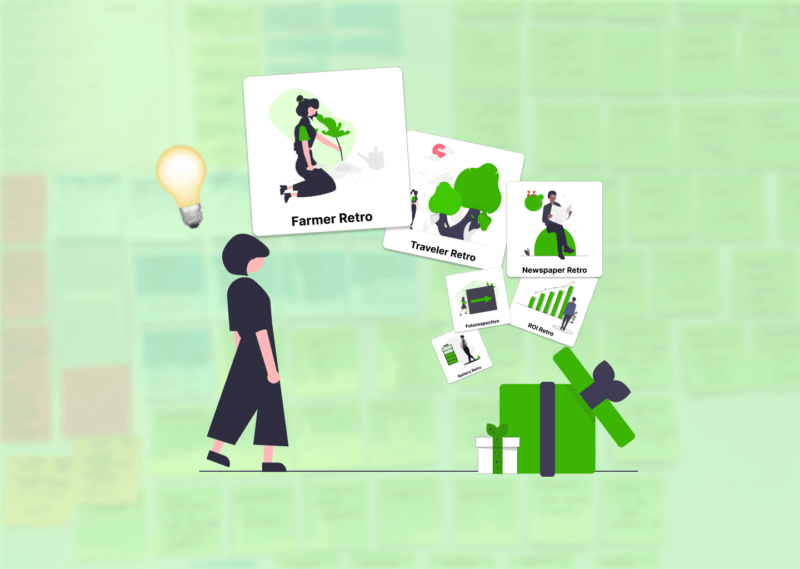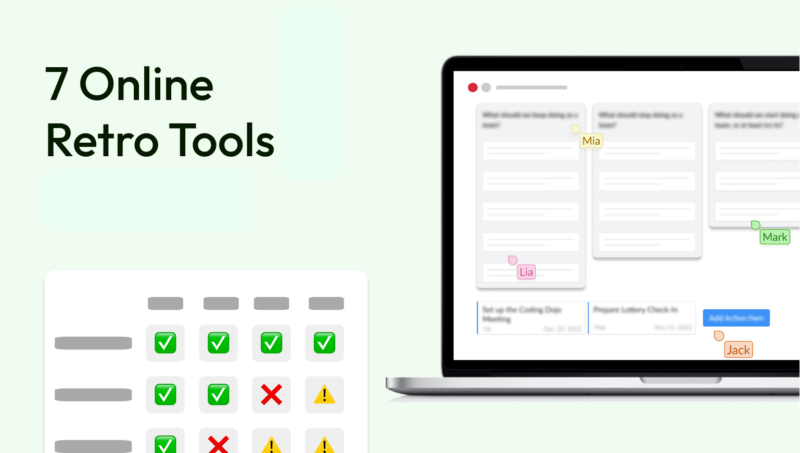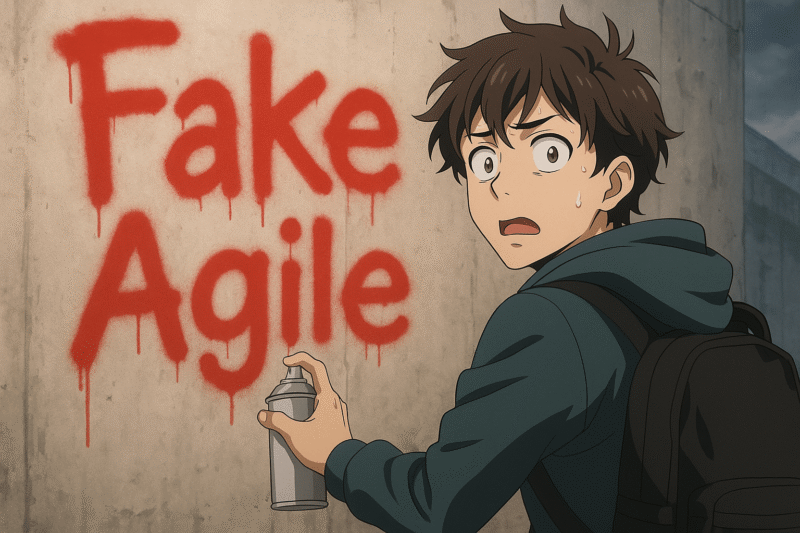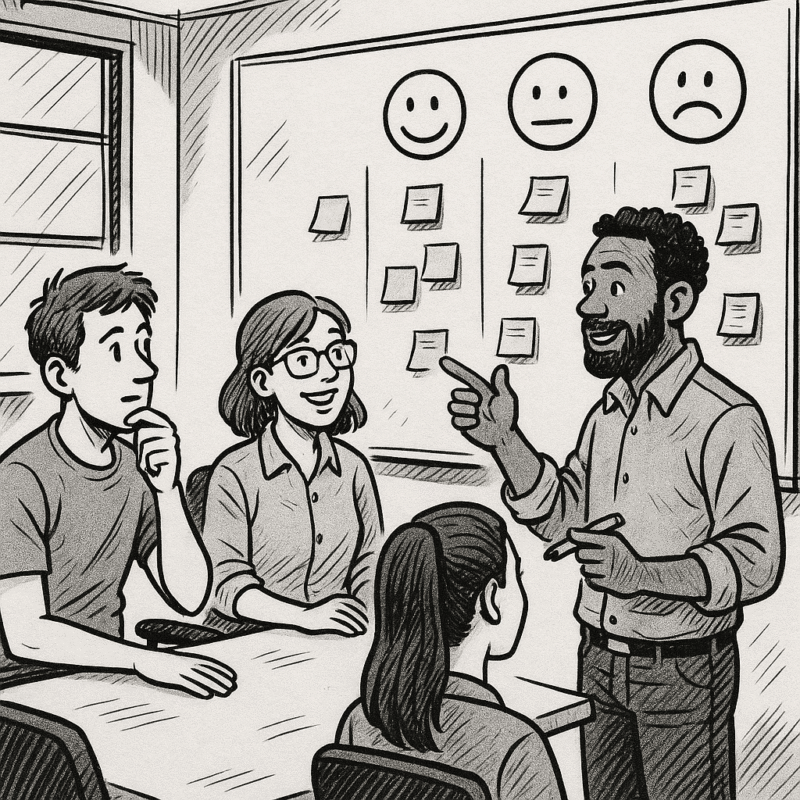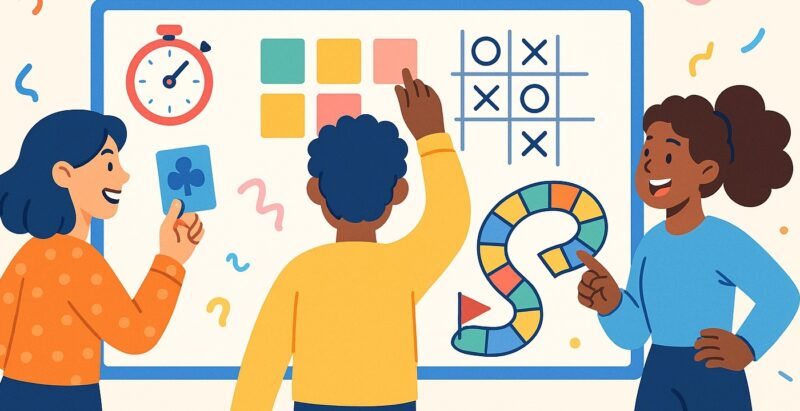Are you looking for unusual icebreakers for the check-in or retrospective check-in methods for your next retrospective? I'm glad to hear that, because a good, interactive check-in or icebreaker can have a very positive effect on the entire retrospective. That's why we've developed some icebreaker questions to help you with that.
Retrospective Icebreaker Methods, Questions & Icebreakers
Creative kickstart for your retrospective
The retro begins with a warm-up: The first of five phase of a retrospective. Not only as a psychologist I can confirm that the perfect check-in has one goal above all: Create psychological safety. In the best case, even rather introverted team members feel a little more confident after this warm-up phase, making it easier for them to open up during the actual retrospective.
How can you achieve this effect? You could write a book about that, but in a nutshell, by showing that everyone on the team is an imperfect human being. Everyone on the team makes mistakes – and that's perfectly fine. By the way, I actually wrote an eBook about this: 12 workshops for team flow & mindset change.
Creative check-in questions and icebreakers to promote psychological safety
Following this rationale, the very first icebreaker could look like this:
- Looking at the last weeks (or sprint), what was your favorite mistake (that might or might not triggered a learning)?
- Rather indirectly, showing that everyone can learn something new: What have you learned over the last weeks (both private or professionally)?
- Rather indirectly, emphasizing that team members need each other: When was the last time you said "thank you" to a team mate? Name the situation. In case you didn't yet articulate your thankfulness, do it now.
Of course, not every icebreaker has to be focused on this goal. You can also focus on laying the stage for the actual retrospective - or simply giving everyone a laugh. Thus, here are some more potential retrospective check in questions
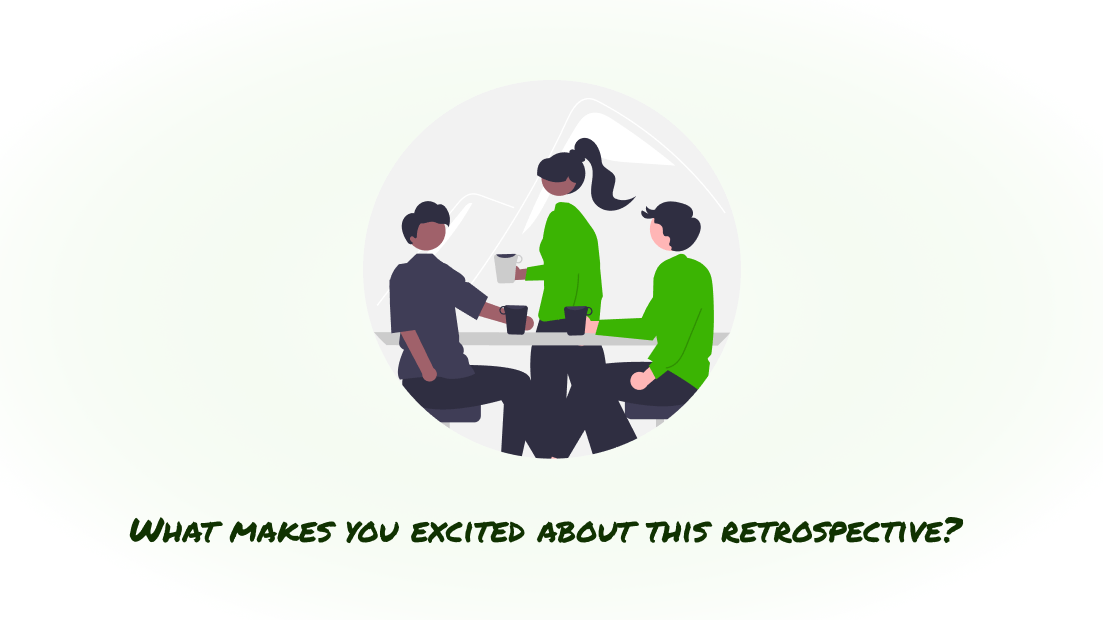
Retrospective Check-in questions, methods & icebreaker classics
The following check-ins and icebreakers are a few classics.
- How has your day been so far?
- In the last week(s): What has given you energy and what has been draining your energy?
- What's giving you energy and joy at the moment?
- What has surprised you positively lately?
- What makes you excited about this retrospective?
- What was the task that took most of your time last week?
- What was the best moment of your day yesterday?
- Name one good thing and one bad thing about your day so far.
- On a scale of 0 (very bad) to 10 (very good), how ready/focused are you for/on this meeting right now?
Retrospective Check-in Questions & Icebreakers for getting to know each other
If your team doesn't know each other very well yet, the following icebreakers are a good way to get to know the new team.
- If you could only eat one meal for the rest of the week, what would it be?
- If you had the rest of the day off, what would you do with that time?
- What is a new and interesting thing you dealt with recently?
- What's been a big news (think of newspapers, TV etc.) lately that you are positively excited about?
More energy in (virtual or remote) space
In my experience, there are certain teams that benefit from becoming a little more active, possibly even physically.
The following smaller exercises or questions go a little more in this direction and should serve as good inspiration.
- Exercise: "Stand up (or raise your hand) if you are in this sprint..."
👉 ...have learned a new tool.
👉 ...had a small sense of achievement.
👉 ...had more meetings than planned. - Exercise: "Draw a cat in 10 seconds with your eyes closed."
👉 A quick, fun drawing exercise that will make you laugh. - Exercise: "Lightning word association"
👉 The moderator says "sprint", everyone spontaneously names a word in turn (e.g. stress, fun, bugs, success...).
- Emoji mood check: Everyone shares their current state of mind with an emoji or a suitable image.
- Draw your current mood: Everyone draws their mood on a virtual or real whiteboard.
- GIF competition: Everyone posts a GIF that describes their current state of mind.
- One Word Icebreaker: Everyone describes the last working period with a single word.
- (Virtual) high-five: Someone raises their hand, says something positive, and the others who feel the same way give a (remote or virtual) high-five – Alternatively, they can also stand up.
- Escape room puzzle: You solve a small logical puzzle or brain teaser together.
- My day in one color: Everyone names a color that describes their current state ("Today I feel like blue – calm and focused").
- Your slogan for the last sprint: Create short, funny advertising slogans ("Code fast, debug later!").
- What is your Spirit Animal for today: Everyone names an animal that reflects their current energy ("I am a turtle – slow, but getting there!").
To give you another format: Of course, you can also design the check-in visually. Here, too, methods that stimulate creativity and possibly have a reference to the last Scrum Sprint are suitable.
Here you can find some nice examples of retrospective check-in games: From our Retrospective & Health Check Tool – Echometer.
Born to lie 👼
1. Retro game on online whiteboard
Duration: 10-20 minutes | Aim: Getting to know each other, analyzing team communication, retrospective games for new teams
Idea: Everyone in the team marks two places on a map - and explains why they were born there. In one of them, they were really born. The other place is a lie.
- Every team member on their own marks the place where they have been born and one additional place (possible on a digital whiteboard).
- Timebox 5 minutes: Next, they have to come up with an explanation for both places why they have been born there.
For example, this is what Julia Rodriguez would say:
A) As you all know, I have been born right around the corner in New York, I mean, this is why I work here and why I am visiting my family every weekend.
B) As you all know, my family name is Rodriguez. I am actually from Mexico City, where I was born 39 years ago. My family moved to the US shortly after my birthday, because my Dad started working here.
Both make sense – what's correct? - Timebox 1 minute per person: The explanation for both places is shared one by one. After one person shared their truth and a lie, everyone in the team guesses which place is the true place of birth.
- In the end, you can delete the “lies” from the map - and you should have a nice map of where the team is from that you might even want to add to your mutual team page.
Scrum Sprint Retrospective Games: Our Sprint Symphony 🎹
16. Remote retrospective game on online whiteboard
Duration: 5-15 minutes | Goal: Setting the stage
Idea: If our last sprint would be a song, what would be the title? Let them choose from given songs or invent their own titles.
One of the rather quick retrospective games:
- You give the instructions.
- 1-2 minute timebox: Everyone chooses a song title from the given list of songs (see screenshot of the whiteboard) or takes a different one.
Everyone is free to change the title of a song. For example, someone might change the title “Eye of the tiger” from Survivor to “Eye of the customer” (e.g., because they met the actual customer for the very first time). - The person who was the first to make a decision begins to explain their choice and hands over to the next person until everyone gave feedback.
- "Something Just Like This" by The Chainsmokers and Coldplay
- I Took a Pill in Ibiza by Mike Posner
- "Rolling in the Deep" by Adele
- "The Twist" by Chubby Checker
- "Yes Sir, I Can Boogie" by Baccarat
- "Party Rock Anthem" by LMFAO
- „Bad Romance“ by Lady Gaga
- „Shape of You“ by Ed Sheeran
- "Rock Around the Clock" by Bill Haley & His Comets
- "Wind of Change" by Scorpions
- "Silent Night" by Bing Crosby
- "I Gotta Feeling" by Black Eyed Peas
- "Uptown Funk" by Mark Ronson (featuring Bruno Mars)
- „Call Me Maybe“ by Carly Rae Jepsen
- "Time to Say Goodbye" by Andrea Bocelli and Sarah Brightman
- "I Don't Care" by Ed Sheeran and Justin Bieber
- Your favorite songs...
Retrospective games for distributed teams: Sprint Animals 🐷
Retro game on the online whiteboard
Duration: 5-15 minutes | Goal: Setting the stage
Idea: If our last sprint would be a face, which one would it be? Let them choose from the given images and explain their choice.
The Retrospective Riddle 🕵🏻♂️
7. Online Whiteboard Game (Retrospective games ideas)
Duration: 45-90 minutes | Goal: Reflecting on the teamwork in general and the last sprint
Idea: A wise wizard has 3 secret, magic questions. Answering them would help the team a lot to improve. But to get to know these questions, the team has to solve 3 riddles first.
- You give an overview over the agenda of today's retrospective.
- 3 minute timebox: The first riddle is presented (see whiteboard above). The team has to solve it as fast as possible. If they are faster than 3 minutes, the remaining time will be added on the time to solve the next riddle.
- 5 minute timebox: The first magic question (a creative retrospective question) from our wizard is presented. E.g.: When thinking about my team, what don't I hear that should be heard?
- 20 minute timebox: Repeat step 2 and 3 with the second and then third riddle, maybe adding the remaining time from the last round.
- Choose from your typical repertoire of retrospective questions to suggest questions. These are some suggestions of magic questions that the wizard could ask:
- When I think about my team, what am I not hearing that should be heard?
- What are you thankful for when you think about the past few weeks?
- What would James Bond do if he had the challenges we face?
- Imagine if we hadn't achieved our team goal. What would have been the reason we didn't achieve it?
- From now on you proceed with the typical 5 phases of an agile retrospective.
- Explaining feedback: After everyone has finished answering the final magic question, everyone's thoughts (and notes) are shared. At this point there is no discussion.
- Prioritization: Each team member has 3 digital points to vote on. Now put the points where you think there is still room for improvement.
- Discussion: Discuss the areas that have the most votes. Do you want to put down an action item?
- Action items: Name a specific person who is responsible for this measure. I recommend not to record more than 3 measures – focus liber on quality instead of quantity (more on this in our post: 7 tips for great action items).
- You want to boil a two-minute egg. If you only have a three-minute timer (hourglass), a four-minute timer, and a five-minute timer, how can you boil the egg for only two minutes?
- Answer: Once the water is boiling, turn the three-minute timer and five-minute timer over. When the three-minute timer runs out, put the egg in the boiling water. When the five-minute timer runs out, two minutes have elapsed and it is time to take the egg out of the water. You don't need the four-minute timer for this riddle.
- Two fathers and two sons went fishing one day. They were there the whole day and only caught 3 fish. One father said, that is enough for all of us, we will have one each. How can this be possible?
- Answer: There was the father, his son, and his son's son. This equals 2 fathers and 2 sons for a total of 3!
- Forward I am heavy, but backward I am not. What am I?
- The word Ton.
- Which of the following words don't belong in the group and why? CORSET, COSTER, SECTOR, ESCORT, COURTS
- Courts. All of the others are anagrams of each other.
- A woman shoots her husband. Then she holds him underwater for over 5 minutes. Finally, she hangs him. But 5 minutes later they both go out together and enjoy a wonderful dinner together. How can this be?
- Answer: The woman was a photographer. She shot a picture of her husband, developed it, and hung it up to dry.
- Attention, only works in English and by reading aloud: There are 30 cows in a field, and 28 chickens. How many didn't?
- Listen closely: 30 cows, and twenty-eight chickens. Say EIGHT and ATE. They sound the same. Therefore, it means 20 ATE chickens. 30-20=10, so 10 cows didn't eat any chickens.
- Sometimes I am born in silence, Other times, no. I am unseen, But I make my presence known. In time, I fade without a trace. I harm no one, but I am unpopular with all. What am I?
- Answer: A fart.
- I am six letters. When you take one away I am twelve. What am I?
- The word "Dozens".
- What type of music do rabbits listen to?
- Fun answer: Hip-hop.
Fun Retro Games Agile: Movie Time 🍿
18. Remote retrospective game on online whiteboard
Duration: 5-15 minutes | Goal: Setting the stage
Idea: If our last sprint was a movie, what would the title be? Let the team choose from predefined films or invent their own titles.
One of the simple, good retrospective games:
- You give the instructions.
- 1-2 minute timebox: Everyone chooses a movie title from the given list of songs (see screenshot of the whiteboard or toggle below) or takes a different one.
Everyone is free to change the title of a movie. For example, someone might change the title “Lord of the rings” to “Lord of the bugs”. That’s a funny one. - The person who was the first to make a decision begins to explain their choice and hands over to the next person until everyone gave feedback.
- Gold fingers
- Titanic
- Lord of the Rings
- Back to the future
- Rain man
- Avatar
- The Birth of a Nation
- Indiana Jones and the Last Crusade
- Paranormal Activity
- 20,000 Leagues Under the Sea
- Furious 7
- Gone with the wind
- Doctor Zhivago
- Spider-Man: No Way Home
- ET the Extra-Terrestrial
- ...
If you like this game you can find more here: The 15 Best Online Retrospective Games. Feel free to check them out 🙂
Fun & creative Retrospective Check In Questions & Icebreakers
- Explain the course of your week as a weather report and forecast.
- What adjective best describes your current emotional state?
- If your last week was a movie - what would have been the headline?
- If your last week was a song – what would it be called?
- If your last week was a newspaper report – what would the headline be?
- Describe the latest revelation you had.
- With whom in our organization would you like to switch roles tomorrow and why?
Quick health check's can also be a fun check-in for retrospective. In health checks, different statements are presented to the team and each team member expresses agreement on a scale.
I have to add that you often drift into the data gathering phase and discussions when doing so – but that should be the goal of icebreakers anyway.
You can open a Health Check Retrospective Check-In directly with our Health Check & Retro tool Echometer and run it online with your team (Echometer- without registration). For example, here is our template on the theme of team spirit – feel free to take a look:
Note: This retrospective format asks for agreement with the given Health Check items on a scale.
- Appreciation: My colleagues appreciate my contribution to the team.
- Team Spirit: There is a trusting working atmosphere in our team.
- Transparency: Everyone in my team knows who is currently working on what.
- Recovery & Breaks: I have enough room for breaks in which I can draw new energy.
- Meeting culture: Our meetings are well structured, yet leave room for creativity and new ideas.
- Support: In my team, each team member passes on their individual knowledge and experience.
Conclusion – Retrospective Icebreaker Questions
I hope this has given you some ideas for your next retrospective. If you'd like to try more interactive check-ins (remote and in-office), feel free to visit the linked post on the best retrospective formats for any situation: 3 interactive check-ins on a whiteboard. By the way, we also have many seasonal retrospective ideas in our tool (for example: 6 Thanksgiving Retrospective Ideas) – like to just take a look and browse a little.
By the way, if you are still looking for a suitable retro board (with 60+ agile retrospective formats), this post can help you: Comparing the 6 best retrospective boards
Most Agile Coaches and Scrum Masters run in circles...
...fixing superficial symptoms. Time to use psychology to foster sustainable mindset change.


